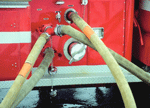Back in 2004, New York City Mayor Michael Bloomberg announced that the city would once again try to modernize its 911 emergency call system. The previous attempt, begun in the early 1990s, ended years later with nothing to show for the tens of millions of dollars sunk into it. Bloomberg's initial $1.3 billion plan called for two call emergency call centers to be constructed (one being a backup), along with a unified computer-aided dispatch (CAD) system covering the Fire Department (FDNY), Emergency Medical Services (FDNY-EMS), and Police Department (NYPD).
In early 2005, HP was hired as the system integrator to develop the first call center and place it into operation by late 2005. The second call center and CAD system were to be completed sometime the next year.
However, it took until 2007 for the current modernization effort, called the Emergency Communications Transformation Program (ECTP), to begin in earnest at a now estimated cost of $1.5 billion and a revised scheduled completion time of 2010. A reason for the delay was the poor oversight and governance of the project by various city department managers, according to a New York City Comptroller audit that came out a couple of weeks ago. The audit report (pdf, press release here) states that "questionable judgment, poor decisions, and deficiencies in ECTP governance structure ... caused key decisions not to be made in a timely manner." For example, the FDNY and NYPD both claimed to "own" the emergency call system. It isn't hard to imagine how the subsequent infighting slowed the project's progress tremendously.
The audit report also notes the original technical effort involved in creating a unified CAD system was sorely underestimated. The CAD system completion date had to be pushed back into the summer of 2007, but continuing issues have meant that even today a unified CAD still is but a wish; nor is there even a definitive date for one to be put into operation. The on-going delay has caused the NYPD to decide to develop its own new CAD system, at a cost of $87.6 million, scheduled to be put into operation sometime late this year; the FDNY is also planning to build a new CAD system of its own at a cost of some $50 million, but a date for its initial operations has not yet been finalized.
The Comptroller's audit goes on to state that the total cost of the two new emergency call centers sans unified CAD system will now land in the neighborhood of $2.3 billion. The first call center went live this January, while the second one is currently scheduled for completion in 2015. The second call center, expected to cost $700 million when complete, is being built by Northrop Grumman, as HP's contract ends this year.
The audit report, which highlighted the enormous cost increase and scheduled delays, caused an expected ruckus, as did the claim by the administration that the 911 project was basically okay and did not have a major cost overrun. The administration argued that the expected higher cost just reflected a better understanding of what was required of the system (i.e., a new set of requirements). When costs for the movie "John Carter" ballooned, at least studio officials didn't claim that it was on-budget for a different movie than originally conceived.
Instead of quieting down as these things usually do after a few weeks, another report, with the title of 911 Call Processing Review, is instead keeping the controversy in the headlines. The review was conducted by a consulting firm on behalf of the Bloomberg Administration to look into the City's widely-criticized emergency services' response to the 2010 Christmas Day snow storm. At the time, the mayor promised "to get at the truth" as to why the emergency services seemed so unprepared.
Well, apparently the truth uncovered is a bit ugly and embarrassing, and the mayor is now refusing to release the study. According to the New York Daily News, the report says that despite all the hundreds of millions of dollars so far spent to improve New York City's emergency call system communications and emergency crew response times, the new capabilities seem to be instead slowing down emergency responders.
Bloomberg claims the report is only a working document, is incomplete, and does not reflect current reality, so he doesn't see any need to release it. The New York State Supreme Court disagreed, ordering the release of the report last Friday, but that order has been stayed by an appeal filed by the administration.
After the criticism the mayor received because of the CityTime scandal, it is not surprising that His Honor isn't anxious to highlight yet another fiasco. But given that it will be years before the second call center is placed into operation, it is likely that he will be hearing complaints about his handling of the project until His Honor's term expires at the end of next year.
Robert N. Charette is a Contributing Editor to IEEE Spectrum and an acknowledged international authority on information technology and systems risk management. A self-described “risk ecologist,” he is interested in the intersections of business, political, technological, and societal risks. Charette is an award-winning author of multiple books and numerous articles on the subjects of risk management, project and program management, innovation, and entrepreneurship. A Life Senior Member of the IEEE, Charette was a recipient of the IEEE Computer Society’s Golden Core Award in 2008.



